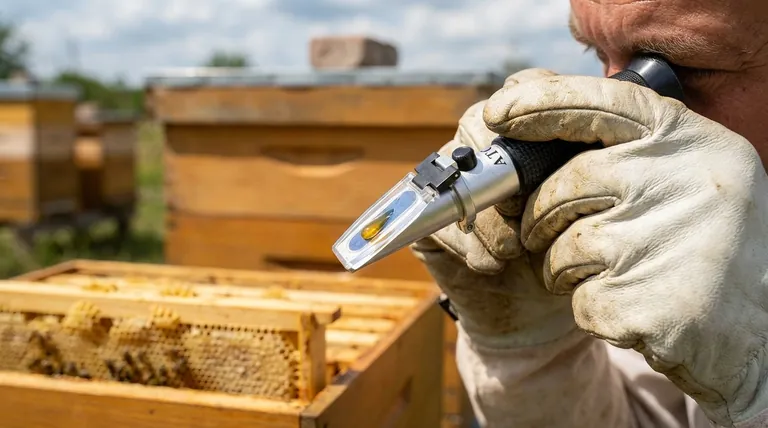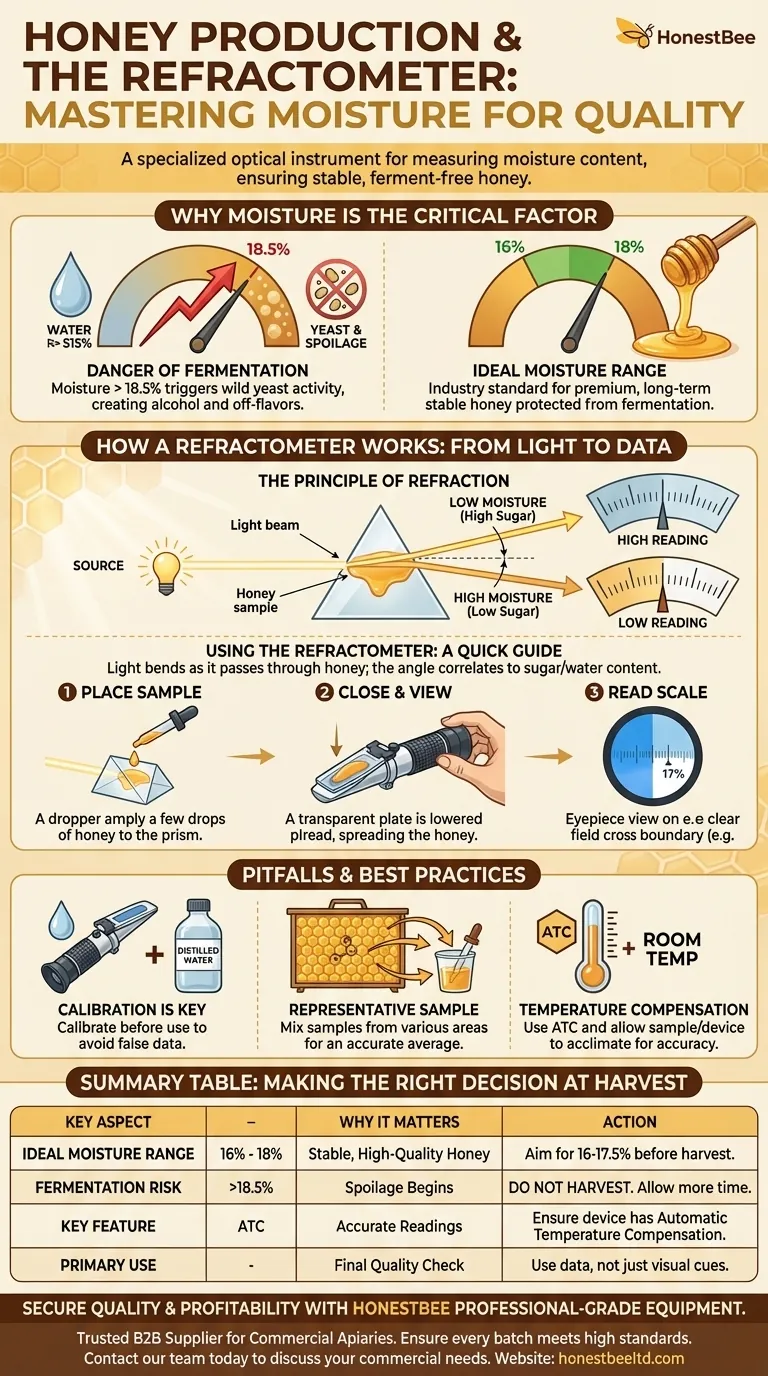In short, a refractometer is a specialized optical instrument used to measure the moisture content of honey. It works by passing light through a honey sample to measure its refractive index, which directly correlates to the percentage of water, allowing beekeepers to determine if the honey is stable enough for harvest and storage without risk of fermentation.
The central challenge in honey production is managing moisture. Too much water allows naturally present yeasts to ferment the honey, ruining its quality and shelf life. A refractometer is the definitive tool that replaces guesswork with precise data, ensuring every harvest is stable, storable, and of the highest quality.

Why Moisture Is the Critical Factor in Honey Quality
The stability of honey is almost entirely dependent on its water content. Understanding this relationship is fundamental to successful beekeeping and honey production.
The Danger of Fermentation
All raw honey contains wild yeasts. At low moisture levels, these yeasts remain dormant due to the high sugar concentration, which effectively dehydrates them through osmosis.
When the moisture content rises above approximately 18.5%, these yeasts can become active. They begin to consume the honey's sugars, producing alcohol and carbon dioxide, which leads to fermentation, off-flavors, and spoilage.
The Ideal Moisture Range
For honey to be considered high-quality and stable for long-term storage, its moisture content must be low. The industry standard and target range for premium honey is typically between 16% and 18%.
Honey within this range is protected from fermentation and will maintain its quality for years.
How a Refractometer Works: From Light to Data
A refractometer provides a simple, immediate way to see the invisible—the water content within your honey. It operates on a reliable principle of physics.
The Principle of Refraction
Refraction is the bending of light as it passes from one medium to another. A refractometer measures the angle of this bend.
The more dissolved solids (sugars) in a liquid, the more it slows down and bends light. Therefore, honey with low moisture (high sugar concentration) will have a higher refractive index than honey with high moisture.
Using the Refractometer: A Quick Guide
Using a honey refractometer is straightforward. A few drops of honey are placed on the prism surface, and a transparent plate is lowered to spread the sample evenly.
You then hold the instrument up to a light source and look through the eyepiece. The internal scale will show a clear reading.
Reading the Scale
Inside the eyepiece, you will see a scale with a boundary line separating a blue field from a white field. The point where this line crosses the scale indicates the honey's moisture content as a percentage.
Common Pitfalls and Best Practices
While simple to use, a refractometer's accuracy depends on proper technique. Avoiding common errors is crucial for obtaining reliable data.
The Importance of Calibration
An uncalibrated refractometer will give you false information, which can lead to disastrous harvesting decisions. Always calibrate your instrument before use, typically with distilled water or the specific calibration oil provided by the manufacturer.
The Need for a Representative Sample
The moisture content can vary slightly across a single frame of honey. Do not rely on a single drop from one honey cell.
For an accurate assessment, take small samples from several different areas of the comb and mix them together before testing. This gives you a more reliable average for the entire frame or super.
Temperature Compensation
Temperature affects a liquid's density and, therefore, its refractive index. Most modern honey refractometers feature Automatic Temperature Compensation (ATC), which corrects for ambient temperature variations.
Even with ATC, it is best practice to allow your honey sample and the refractometer to acclimate to room temperature before taking a reading.
Making the Right Decision at Harvest Time
The refractometer is your final quality checkpoint. It empowers you to make an informed decision based on data, not just visual cues like capped cells.
- If your primary focus is premium quality and long-term storage: Aim for a moisture content between 16% and 17.5% before harvesting.
- If your readings are consistently above 18.5%: Do not harvest. Allow the bees more time to dehydrate the nectar and cap the cells.
- If you are blending honey from different hives or harvests: Use the refractometer to test each batch and the final blend to ensure the overall moisture level remains safely below the fermentation threshold.
Ultimately, a refractometer transforms guessing into knowing, securing the quality and value of every harvest.
Summary Table:
| Key Aspect | Why It Matters |
|---|---|
| Ideal Moisture Range | 16% - 18% for stable, high-quality honey that resists fermentation. |
| Fermentation Risk | Begins when moisture content exceeds approximately 18.5%. |
| Key Feature | Automatic Temperature Compensation (ATC) for accurate readings. |
| Primary Use | Final quality check before harvesting to replace guesswork with data. |
Secure the quality and profitability of every harvest with professional-grade equipment from HONESTBEE.
As a trusted wholesale supplier to commercial apiaries and beekeeping equipment distributors, we provide the reliable tools you need for precision and efficiency. Ensure every batch of honey meets the highest quality standards.
Contact our team today to discuss your commercial beekeeping supply needs.
Visual Guide

Related Products
- Precision Honey Refractometer Instrument for Quality Assessment
- High Quality Honey Dehumidifier Dryer Thickening Machine for Beekeeping
- 10L Stainless Steel Electric Honey Press Machine
- Natural Wood Honey Dipper for Tea Coffee and Desserts
- Premium Diamond-Faceted Glass Honey Dispenser
People Also Ask
- What are the key steps to using a honey refractometer? Ensure Honey Quality & Prevent Fermentation
- How does a honey refractometer work? Ensure Honey Quality & Harvest Readiness
- Why is a honey refractometer essential for honey harvesting? Protect Your Harvest from Spoilage
- What is a honey refractometer? The Essential Tool for Perfect Honey Quality
- What are the key points for proper usage of a honey refractometer? Ensure Accurate Moisture Readings Every Time



















